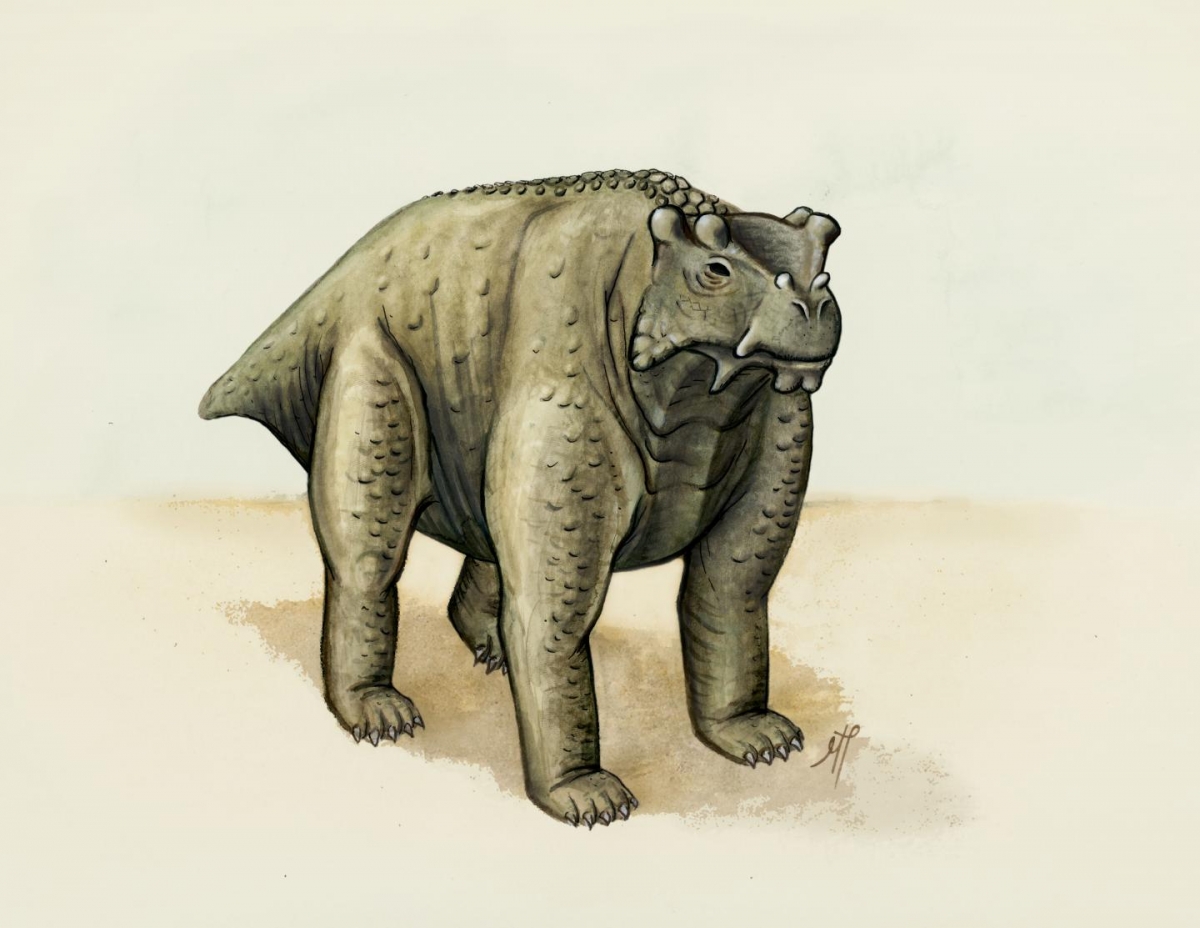Post by Infinity Blade on Sept 25, 2015 8:25:56 GMT 5
Bunostegos akokanensis

A restoration of Bunostegos.
Temporal range: Late Permian (Wuchiapingian: ~260Ma)
Scientific classification:
Domain: Eukaryota
(unranked): Unikonta
(unranked): Opisthokonta
(unranked): Holozoa
(unranked): Filozoa
Kingdom: Animalia
Subkingdom: Eumetazoa
(unranked): Bilateria
Superphylum: Deuterostomia
Phylum: Chordata
Infraphylum: Gnathostomata
Clade: Eugnathostomata
Clade: Teleostomi
Superclass: Tetrapoda
Clade: Reptiliomorpha
Clade: Amniota
Class: Reptilia or Clade: Sauropsida
Clade: †Parareptilia
Order: †Procolophonomorpha
Clade: †Hallucicrania
Clade: †Procolophonia
Clade: †Pareiasauromorpha
Superfamily: †Pareiasauroidea
Clade: †Pareiasauria
Family: †Pareiasauridae
Genus: †Bunostegos
Species: †B. akokanensis
Bunostegos ("knobby skull roof") is a genus of pareiasaur that lived in what is now the Moradi Formation of Niger ~260 million years ago.[1]
Description:
The skull of Bunostegos had large bony knobs on it, which were covered in skin, similar to a giraffe.[2] The knobs are believed to have functioned in interspecific or intraspecific recognition.[3] Like all pareiasaurs, the body was adorned with osteoderms.[2]

Facial reconstruction of Bunostegos.
In 2015, the limb elements of Bunostegos were described.[4] Other pareiasaurs are known to have moved in a sprawling gait. But the limb bones of Bunostegos had a morphology that would have prevented a sprawling posture and the limbs overall were directed underneath the body.[5] More specifically, "Bunostegos exhibits skeletal features that parallel those seen in clades with parasagittal posture. The combination of features noted above (i.e., the ventrally directed glenoid with remarkable buttress reinforcement and centered scapular shaft, the untwisted humerus with both planes of articulation in line and oriented anteroposteriorly, and the restrictive hinge-like elbow joint) is sprawling-prohibitive and leaves the only possible orientation of the forelimb to be directed vertically beneath the body, giving Bunostegos a parasagittal forelimb stance. This set of morphologies is reminiscent of that in multituberculates and therians (Sereno and McKenna, 1995; Sereno, 2006).". It is believed an erect gait evolved because such a method of locomotion would have been been more energy-efficient in a desert ecosystem with scarce vegetation, which would have required extensive travel to be found.[4] It is now regarded as the first known organism to have had a completely erect gait.[5]
Phylogenetic relationships:
Bunostegos was most closely related to basal pareiasaurs. Therefore, it must have been a part of a lineage that lived in isolation in central Pangea for millions of years. The exceptionally dry central Pangea was climatically isolated, allowing Bunostegos and other more basal fauna to survive in the area.[3] It probably perished with its fellow pareiasaurs during the Permian-Triassic extinction event ~252 million years ago.[2]
References:
[1] "The vertebrate fauna of the Upper Permian of Niger - ll, Preliminary description of a new pareiasaur" (Sidor et al., 2003).
[2] This Bumpy-Faced Reptile Ruled the Prehistoric Desert (article by Joseph Stromberg)
[3] Knobbly reptile roamed vast ancient desert
[4] "The vertebrate fauna of the upper Permian of Niger-IX. The appendicular skeleton of Bunostegos akokanensis (Parareptilia:Pareiasauria)" (Turner et al., 2015).
[5] Bunostegos akokanensis is Earliest Known Creature to Walk Upright on All Fours

A restoration of Bunostegos.
Temporal range: Late Permian (Wuchiapingian: ~260Ma)
Scientific classification:
Domain: Eukaryota
(unranked): Unikonta
(unranked): Opisthokonta
(unranked): Holozoa
(unranked): Filozoa
Kingdom: Animalia
Subkingdom: Eumetazoa
(unranked): Bilateria
Superphylum: Deuterostomia
Phylum: Chordata
Infraphylum: Gnathostomata
Clade: Eugnathostomata
Clade: Teleostomi
Superclass: Tetrapoda
Clade: Reptiliomorpha
Clade: Amniota
Class: Reptilia or Clade: Sauropsida
Clade: †Parareptilia
Order: †Procolophonomorpha
Clade: †Hallucicrania
Clade: †Procolophonia
Clade: †Pareiasauromorpha
Superfamily: †Pareiasauroidea
Clade: †Pareiasauria
Family: †Pareiasauridae
Genus: †Bunostegos
Species: †B. akokanensis
Bunostegos ("knobby skull roof") is a genus of pareiasaur that lived in what is now the Moradi Formation of Niger ~260 million years ago.[1]
Description:
The skull of Bunostegos had large bony knobs on it, which were covered in skin, similar to a giraffe.[2] The knobs are believed to have functioned in interspecific or intraspecific recognition.[3] Like all pareiasaurs, the body was adorned with osteoderms.[2]

Facial reconstruction of Bunostegos.
In 2015, the limb elements of Bunostegos were described.[4] Other pareiasaurs are known to have moved in a sprawling gait. But the limb bones of Bunostegos had a morphology that would have prevented a sprawling posture and the limbs overall were directed underneath the body.[5] More specifically, "Bunostegos exhibits skeletal features that parallel those seen in clades with parasagittal posture. The combination of features noted above (i.e., the ventrally directed glenoid with remarkable buttress reinforcement and centered scapular shaft, the untwisted humerus with both planes of articulation in line and oriented anteroposteriorly, and the restrictive hinge-like elbow joint) is sprawling-prohibitive and leaves the only possible orientation of the forelimb to be directed vertically beneath the body, giving Bunostegos a parasagittal forelimb stance. This set of morphologies is reminiscent of that in multituberculates and therians (Sereno and McKenna, 1995; Sereno, 2006).". It is believed an erect gait evolved because such a method of locomotion would have been been more energy-efficient in a desert ecosystem with scarce vegetation, which would have required extensive travel to be found.[4] It is now regarded as the first known organism to have had a completely erect gait.[5]
Phylogenetic relationships:
Bunostegos was most closely related to basal pareiasaurs. Therefore, it must have been a part of a lineage that lived in isolation in central Pangea for millions of years. The exceptionally dry central Pangea was climatically isolated, allowing Bunostegos and other more basal fauna to survive in the area.[3] It probably perished with its fellow pareiasaurs during the Permian-Triassic extinction event ~252 million years ago.[2]
References:
[1] "The vertebrate fauna of the Upper Permian of Niger - ll, Preliminary description of a new pareiasaur" (Sidor et al., 2003).
[2] This Bumpy-Faced Reptile Ruled the Prehistoric Desert (article by Joseph Stromberg)
[3] Knobbly reptile roamed vast ancient desert
[4] "The vertebrate fauna of the upper Permian of Niger-IX. The appendicular skeleton of Bunostegos akokanensis (Parareptilia:Pareiasauria)" (Turner et al., 2015).
[5] Bunostegos akokanensis is Earliest Known Creature to Walk Upright on All Fours



